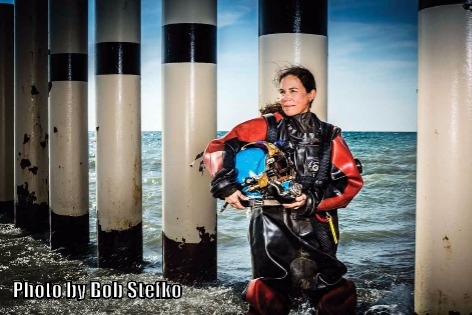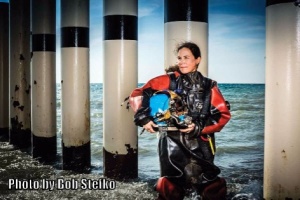5 Most Extreme Scuba Diving Jobs

Don’t Try This at Home
Following is a list of the world’s most extreme scuba diving jobs.
For these five divers the underwater experience is significantly different than that of a recreational diver. It’s a job, and a challenging one at that. They earn their living in a dangerous environment where they must rely on their experience and skill to keep them safe.
This is an excerpt from an article by Travis Marshall on ScubaDiving.com.
Nuclear Reactor Diver
Before she went to commercial-diving school, Kyra Richter had been a scuba diver for 10 years, working as a dive instructor in Asia and the Caribbean, and as a technical cave diver in Mexico’s cenotes. “Despite all this, I knew as a woman I’d have a hard time in the male-dominated environment of offshore commercial diving, even though my dream was to be a saturation diver,” she says. “One of my instructors had photos of himself working in a nuclear plant, and it fascinated me from day one.”
Today, Richter is a nuclear-dive-program supervisor for a plant in Michigan and has consulted on programs in the United Arab Emirates and South Korea. “Nuclear diving is a mix of inland and industrial diving, which means we work in rivers, lakes and oceans, and in man-made intake tunnels, condensers, pools, tanks and other structures inside the plant,” Richter explains. “We work in open or closed systems, clean or dirty water, which is contaminated water that contains radioactive isotopes.”
But for all the eyebrow-raising nuclear diving might cause, Richter says it’s one of the safest forms of commercial diving. “There is a lot less expense-cutting and a lot more support from the industry to appropriately staff a job,” she says. However, that doesn’t mean it’s without risk.
Criminal Investigator
“Every bridge is a potential dump site, where a murderer can toss a weapon with a flick of the wrist and think it’s gone forever,” says Michael Berry, founder and president of Underwater Criminal Investigators. “It’s my job to not only find these items, but also recover them in a way that preserves any fingerprints, DNA or other evidence that might be left behind.”
The worst problem he encountered came from bacteria. “I was diving in a rock quarry that had turned to mud over the years, looking for stolen merchandise, and I came across a bag filled with the rotting corpses of puppies and kittens,” he says. “I ended up catching meningitis and was out of commission for months — it almost killed me.”
Deadhead Logger
For technical-diving instructor John Claytor, the swamps and river-beds of Florida and Georgia are a treasure trove of lost old-growth lumber. Claytor says experts estimate around 10 percent of those logs [old growth trees] were lost when barges carrying them sank. The low oxygen content at the bottom of these rivers and lakes preserved the wood, and the scarcity of the logs makes them valuable.
Today, Claytor and his son bring the trees up, dry them out, cut them into lumber, and then use them to create custom projects like furniture and flooring. But the work, called deadhead logging, is one of the most dangerous types of logging.
Safety/Croc Wrangler
South African divemaster Richard Bolter has a truly unpredictable and dangerous diving job in a rare niche of his own creation. “More people have gone to the moon than do what I do,” he says. That’s because he’s a fixer and safety diver who specializes in arranging and leading diving expeditions for underwater photographers who wish to go face to face with deadly, man-eating Nile crocodiles in Botswana’s famed Okavango Delta.
The most important rule: Never spend any time on the water’s surface, which sparks the crocs’ attention. “It’s military-style diving getting in and out of the water,” he says. Bolter also carefully vets any divers who want to hire him, and limits his services to professional documentary-film crews.
Bolter says the key to successful encounters is cruising the canals, looking for crocodiles sunning themselves on the banks. “Usually they slip into the water when we pass by,” he says. “Then we jump in upstream and ride the current to where I predict they’ll settle on the bottom.” Underwater, the crocs are often placid, or at least have little interest in the divers. “They have very poor eyesight underwater, so they don’t really notice us, even up close,” he says. “But if you touch them anywhere near the side of the face, they attack.”
Offshore Saturation Diver
In the world of commercial divers, saturation diving is the endgame,” says Brian Lacey, a commercial and saturation diver based in Houston who freelances for oil and gas companies.. “It’s the job everyone wants, and the only reason any of us do it is the money — it’s like being in jail for a month at a time.”
That’s because saturation divers do their work while living inside a diving bell or compression chamber… Saturation divers go under pressure and stay there until their bodies becomes saturated with nitrogen and can’t absorb any more. Saturated divers can dive indefinitely at great depths, as long as they stay under pressure. When the job is done, they’re slowly decompressed inside the chamber.
“A standard run is 30 days down, with a two-man team taking turns, working five hours at a time in the water,” Lacey explains.
You can read the entire article by clicking here.











